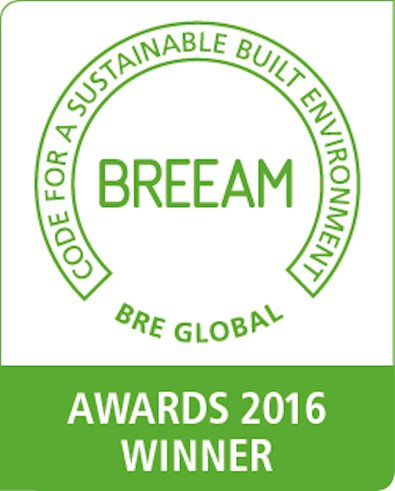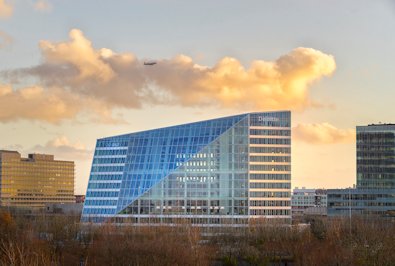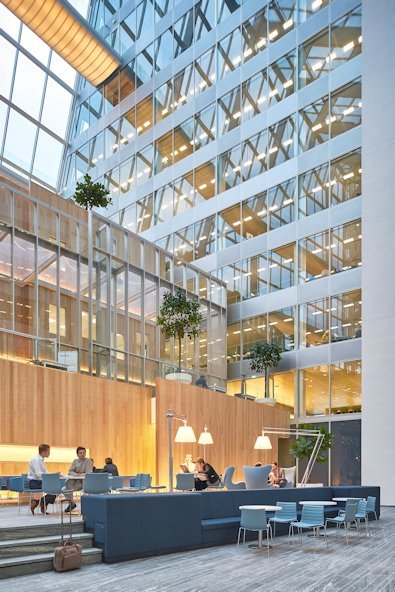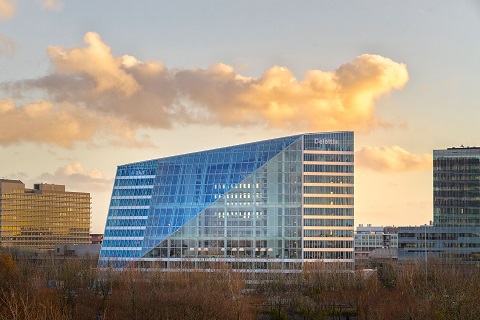Awarded the BREEAM Award for Offices New Construction in 2016, and the public vote for the prestigious Your BREEAM Award
Project Details
- Scheme & Version: BREEAM NL New Construction
- Stage: Final
- Location: Amsterdam, Netherlands
- Score & Rating: 98.3% Outstanding
- Certificate Number: 29-NOP-2010

Project Team
- Developer: OVG Real Estate
- Architects: PLP Architecture
- Main Tenant: Deloitte
- Interior Architects: Fokkema & Partners
- Structural Engineer: Van Rossum Consulting Engineers
- MEP Consultant: Deerns
- Local Architect: OeverZaaijer
- Sustainability Consultant: C2N Bouwmanagement
- Building Physics: LBP Sight
- Landscape Design: Delta Vorm Groep
- Contractor: G&S Bouw
- Façade Contractor: Rollecate
- Glass Roof: Brakel Atmos
- Advisors: Deerns, HC Groep
- Partners: Philips & MapiQ
About the building
The Edge is a 40,000m² Office building in the Zuidas business district in Amsterdam. It was designed for the global financial firm and main tenant, Deloitte. The project aimed to consolidate Deloitte’s employees from multiple buildings throughout the city into a single environment, and to create a ‘smart building’ to act as a catalyst for Deloitte’s transition into the digital age.
The Edge creates a radically new working environment that is enabled by sustainable technologies. With the world’s highest BREEAM rating awarded to an office building, it integrates numerous smart technologies to create adaptable and intelligent work spaces. The building demonstrates that the pursuit of a vibrant and collaborative working environment can be combined successfully with achieving the highest levels of sustainability.
The Edge underwent BREEAM certification as a way of measuring the most innovative aspects of its design and realisation. The overall concept of the building was always to be exemplary, to stand out from the crowd as a futureproof office that raises standards in the Netherlands and internationally. But no rating can fully convey the success of the project on a social level: happy, comfortable and healthy workers who are more productive because of the environment they work in.

OVG REAL ESTATE SAYS: “Sustainability is about more than a great sustainability rating. It is also about a building’s overall comfort and efficiency for its occupiers, so that they can operate with ease in a productive and healthy environment. Furthermore, an inspirational and healthy environment attracts talent and leads to higher employee satisfaction. An environment such as The Edge leads to lower energy and maintenance costs, reduced sickness leave and higher productivity which ultimately achieves a much better financial performance. Thanks to the BREEAM criteria the use of construction materials and costs per square metre was significantly reduced.
By using the BREEAM certification method, we have given a platform to The Edge. As BREEAM allows for benchmarking of sustainability amongst buildings, it accelerates the development of intelligent and sustainable buildings across the globe. BREEAM certification stimulates the demand for sustainable projects, classifying buildings according to their environmental impact and rewarding those that go above and beyond the legal requirement.”
Exemplary Innovation
BREEAM helped the team to develop an office building that is not only energy neutral but also energy positive. The Edge uses 70% less electricity than comparable office buildings. The roof and the south-facing facade incorporate the largest array of photovoltaic panels of any European office building, and an aquifer thermal energy storage system provides all of the energy required for heating and cooling. A heat-pump was applied to this storage system significantly increases efficiency. These and several other innovations (see below) have ensured that The Edge scored particularly well on innovation credits.
Occupancy, movement, lighting levels, humidity and temperature are continuously measured, and using smart technology – including Ethernet-powered LED connected lighting – the building systems respond to maximise efficiency. But the real outcome of The Edge is not just the reduction in water and energy use of its own users, but also the project’s role as a feasible, high quality example of new technologies, new ways of designing, and news ways of working.

Environmental Features
Orientation – The building’s orientation is based on the path of the sun. The atrium bathes the building in northern daylight while the solar panels on the southern facade shield the workspaces from the sun.
Façades – Each facade is uniquely detailed according to its orientation and purpose:
- Load bearing walls to the south, east and west have smaller openings to provide thermal mass and shading, and solid openable panels for ventilation.
- Louvers on the south facades are designed according to sun angles and provide additional shading for the office spaces, reducing solar heat gain.
- Solar panels on the south facade provide enough sustainable electricity to power all smartphones, laptops and electric cars.
- The North facades are highly transparent and use thicker glass to dampen noise from the motorway.
- The Atrium façade is totally transparent, allowing views out over the dyke, and steady north light in.
Smart lighting – The building’s Ethernet-powered LED lighting system is integrated with 30,000 sensors to continuously measure occupancy, movement, lighting levels, humidity and temperature, allowing it to automatically adjust energy use.
Solar panel roof
65.000 sq ft of solar panels are located on the facades and roof, and remotely on the roofs of buildings of the University of Amsterdam – thereby making use of neighbourhood level energy sourcing.
Energy reuse – The atrium acts as a buffer between the workspace and the external environment. Excess ventilation air from the offices is used again to air condition the atrium space. The air is then ventilated back out through the top of the atrium where it passes through a heat exchanger to make use of any warmth.
Rain water reuse – Rain water is collected on the roof and used to flush toilets, and irrigate the green terraces in the atrium and other garden areas surrounding the building.
Thermal energy storage – Two 129m deep wells reach down to an aquifer, allowing thermal energy differentials to be stored deep underground.
Light over Ethernet – In The Edge a new LED-lighting system has been co-developed with Philips. The Light over Ethernet (LoE) LED system is powered by Ethernet and 100% IP based. This makes the system (i.e. each luminaire individually) computer controllable, so that changes can be implemented quickly and easily without opening suspended ceilings. The luminaires are furthermore equipped with Philips’ ‘coded-light’ system allowing for a highly precise localisation via smartphone down to 20cm accuracy, much more precise than known WiFi or beacon systems.
Around 6,000 of these luminaires were placed in The Edge with every second luminaire being equipped with an additional multi-sensor to detect movement, light, infrared and temperature.
The Philips LoE LED system was used in all office spaces to reduce the energy requirement by around 50% compared to conventional TL-5 Lighting. Via the LoE system daily building use can be monitored. This data is fed to facility managers via the BMS allowing:
- Remote insight into the presence of people in the building (anonymous). Heating, cooling, fresh air and lighting are fully IoT (Internet of Things) integrated and BMS controlled per 200 sqft based on occupancy – with zero occupancy there is next-to-zero energy use.
- Predictions of occupancy at lunchtime based on real time historical data and traffic and weather information to avoid food-waste.
- Unused rooms to be skipped for cleaning.
- Managers to be alerted to lights that need replacing.
- Notification of printers needing paper.
The mobile app – personalised workspaces – Every employee is connected to the building via an app on their smartphone. Using the app they can find parking spaces, free desks or other colleagues, report issues to the facilities team, or even navigate within the building.
Employees can customise the temperature and light levels anywhere they choose to work in the building via the mobile app. The app remembers how they like their coffee, and tracks their energy use so they’re aware of it.
Data – The vast amount of data generated by the building’s digital systems and the mobile app on everything from energy use to working patterns, has huge potential for informing not only Deloitte’s own operations, but also our understanding of working environments as a whole. Discussions are currently ongoing regarding the future of this data and its use for research and knowledge transfer.
Ecological corridor – The greenspace that separates the building from the nearby motorway acts as an ecological corridor, allowing animals and insects cross the site safely.

